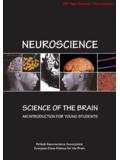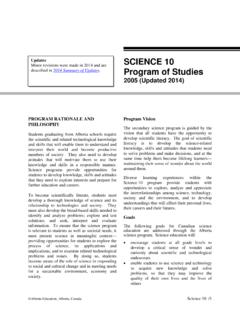Transcription of NEUROSCIENCE - McMaster University
1 NEUROSCIENCESCIENCE OF THE BRAINAN INTRODUCTION FOR YOUNG STUDENTSB ritish NEUROSCIENCE AssociationEuropean Dana Alliance for the BrainNeuroscience: the Science of the BrainInside our heads, weighing about kg, is an astonishing living organ consisting ofbillions of tiny cells. It enables us to sense the world around us, to think and to human brain is the most complex organ of the body, and arguably the mostcomplex thing on earth . This booklet is an introduction for young this booklet, we describe what we know about how the brain works and how muchthere still is to learn. Its study involves scientists and medical doctors from manydisciplines, ranging from molecular biology through to experimental psychology, aswell as the disciplines of anatomy, physiology and pharmacology. Their sharedinterest has led to a new discipline calledneuroscience - the science of the brain described in our booklet can do a lot but not everything.
2 It has nerve cells- its building blocks - and these are connected together in networks. These networks are in a constant state of electrical and chemical activity. The brain wedescribe can see and feel. It can sense pain and its chemical tricks help control theuncomfortable effects of pain. It has several areas devoted to co-ordinating ourmovements to carry out sophisticated actions. A brain that can do these and manyother things doesn t come fully formed: it develops gradually and we describe someof the key genes involved. When one or more of these genes goes wrong, variousconditions develop, such as dyslexia. There are similarities between how the braindevelops and the mechanisms responsible for altering the connections betweennerve cells later on - a process called neuronal plasticity.
3 Plasticity is thought tounderlie learning and remembering. Our booklet s brain can remember telephonenumbers and what you did last Christmas. Regrettably, particularly for a brainthat remembers family holidays, it doesn t eat or drink. So it s all a bit limited. But it does get stressed, as we all do, and we touch on some of the hormonal andmolecular mechanisms that can lead to extreme anxiety - such as many of us feel inthe run-up to examinations. That s a time when sleep is important, so we let it havethe rest it needs. Sadly, it can also become diseased and techniques, such as special electrodes that can touch the surface of cells,optical imaging, human brain scanning machines, and silicon chips containingartificial brain circuits are all changing the face of modern introduce these to you and touch on some of the ethical issues and socialimplications emerging from brain Nervous SystemP22 Neurons and theAction PotentialP43 Chemical MessengersP74 Drugs and the BrainP95 Touch and PainP116 VisionP147 MovementP198 The DevelopingP22 Nervous System9 DyslexiaP2510 PlasticityP2711 Learning and MemoryP3012 StressP3513 The Immune SystemP3714 SleepP3915 Brain ImagingP4116 Artificial Brains andP44 Neural Networks 17 When things go wrongP4718 NeuroethicsP5219 Training and CareersP5420 Further Reading andP56 AcknowledgementsThe NEUROSCIENCE Communityat the University of EdinburghThe EuropeanDana Alliancefor the BrainTo o rd e r additional copies: Online ordering.
4 The British NEUROSCIENCE Association, c/o: The Sherrington Buildings, Ashton Street, Liverpool L68 3 GETelephone: 44 (0) 151 794 4943/5449 Fax: 44 (0) 794 5516/5517 This booklet was prepared and edited on behalf of the British NEUROSCIENCE Association and the European Dana Alliance forthe Brain by Richard Morris ( University of Edinburgh) and Marianne Fillenz ( University of Oxford). The graphic design was byJane Grainger (Grainger Dunsmore Design Studio, Edinburgh). We are grateful for contributions from our colleagues in theDivision of NEUROSCIENCE , particularly Victoria Gill, and others in the NEUROSCIENCE community in Edinburgh. We also thankmembers of the University Department of Physiology in Oxford, particularly Colin Blakemore, and helpful colleagues in otherinstitutions. Their names are listed on the back British NEUROSCIENCE Association (BNA)is the professional body in the United Kingdom that represents neuroscientists and is dedicated towards a better understanding of the nervous system in health and disease.
5 Its members range from established scientists holding positions in Universities and Research Institutes through to postgraduate students. The BNA s annual meetings, generally held in the spring, provide a forum for the presentation of thelatest research. Numerous local groups around the country hold frequent seminars and these groups often organise activities with the general public such as school visits and exhibitions in local museums. See further goal of The European Dana Alliance for the Brain (EDAB)is to inform the general public and decision makers about the importance of brain research. EDAB aims to advance knowledge about the personal and public benefits of NEUROSCIENCE andto disseminate information on the brain, in health and disease, in an accessible and relevant way. Neurological and psychiatric disorders affect millions of people of all ages and make a severe impact on the national economy.
6 To help overcome these problems, in 1997, 70 leading European neuroscientists signed a Declaration of Achievable Research Goalsand made a commitment to increase awareness of brain disorders and of the importance of NEUROSCIENCE . Since then, manyothers have been elected, representing 24 European countries. EDAB has more than 125 members. See further images on this page are of neurons of the cerebral cortex visualised using special dyes inserted into the adjacent by The British NEUROSCIENCE AssociationThe Sherrington BuildingsAshton StreetLiverpoolL69 3 GEUKC opyright British NEUROSCIENCE Association 2003 This book is in copyright. Subject to statutoryexception and the provisions of relevant collectivelicensing agreements, no reproduction of any partmay take place without the written permission ofThe British NEUROSCIENCE AssociationFirst Published 2003 ISBN: 0-9545204--0-8 The NervousSystem2 Basic structureThe nervous system consists of the brain, spinal cord andperipheral nerves.
7 It is made up of nerve cells, calledneurons, and supporting cells called glial are three main kinds of neurons. Sensory neuronsarecoupled to receptors specialised to detect and respond to different attributes of the internal and externalenvironment. The receptors sensitive to changes in light,sound, mechanical and chemical stimuli subserve the sensorymodalities of vision, hearing, touch, smell and taste. When mechanical, thermal or chemical stimuli to the skinexceed a certain intensity, they can cause tissue damageand a special set of receptors called nociceptors are activated; these give rise both to protective reflexes and tothe sensation of pain (see chapter 5 on Touch and Pain).Motor neurons, which control the activity of muscles, areresponsible for all forms of behaviour including between sensory and motor neurons areInterneurones.
8 These are by far the most numerous (in thehuman brain). Interneuronsmediate simple reflexes as wellas being responsible for the highest functions of the brain. Glial cells, long thought to have a purely supporting function to the neurons, are now known to makean important contribution to the development of the nervous system and to its function in the adult brain. While much more numerous, they do not transmit information in the way that neurons do. Neurons have an architecture that consists of a cell bodyand two sets of additional compartments called processes . One of these sets are called axons; their job isto transmit information from the neuron on to others towhich it is connected. The other set are called dendrites-their job is to receive the information being transmitted bythe axons of other neurons.
9 Both of these processes participate in the specialised contacts called synapses(see the Chapters 2&3 on Action Potential and ChemicalMessengers). Neurons are organised into complex chainsand networks that are the pathways through which information in the nervous system is brain and spinal cord are connected to sensory receptors and muscles through long axons that make up the peripheral nerves. The spinal cordhas two functions: it is the seat of simple reflexes such as the kneejerk and the rapid withdrawal of a limb from a hot object or apinprick, as well as more complex reflexes, and it forms ahighway between the body and the brain for information travelling in both basic structures of the nervous system are the samein all vertebrates. What distinguishes the human brain is itslarge size in relation to body size.
10 This is due to an enormousincrease in the number of interneurons over the course ofevolution, providing humans with an immeasurably wide choiceof reactions to the of the BrainThe brain consists of the brain stemand the brain stem is divided into hind-brain, mid-brain and a between-brain called the diencephalon. The hind-brain is anextension of the spinal cord. It contains networks ofneurons that constitute centres for the control of vitalfunctions such as breathing and blood pressure. Withinthese are networks of neurons whose activity controls thesefunctions. Arising from the roof of the hind-brain is thecerebellum, which plays an absolutely central role in the control and timing of movements (See Chapters onMovement and Dyslexia). The midbrain contains groups of neurons, each of which seemto use predominantly a particular type of chemical messenger, but all of which project up to cerebral hemispheres.



